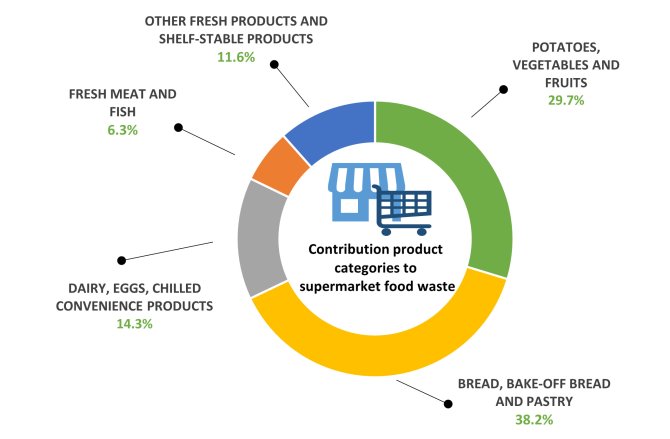In 2022, supermarkets sold an average of 98.62% of the total amount of food that they offered. This means that 1.38% of their food did not reach consumers. This indicates that there was a 13.8% decrease in the amount of food waste* in supermarkets in comparison to 2020 and also shows that food waste* in supermarkets has decreased by 17.4% since 2018. These are the findings from research that was carried out by Wageningen University & Research (WUR) on the basis of self-reporting by supermarkets.
Eight Dutch retail supermarket chains (regular and online activities) took part in this self-reporting exercise: Albert Heijn, Aldi, DekaMarkt, Dirk, Jumbo, Lidl, Picnic and PLUS. Together they represent approximately 85% of the Dutch market. The HelloFresh meal-kit company also provided data.
The 1.38% of products that were not sold within the supermarket channel in 2022 can be distributed across five product categories. In 2022, a decrease was measured in the proportion of 'potatoes, vegetables and fruit', 'fresh meat and fresh fish', 'dairy, eggs and chilled convenience products' and 'other fresh products and shelf-stable products'. There was an increase in the total proportion of 'bread, bake-off bread and pastry'.

Decrease in food waste since 2018 by product category
The supermarket industry has been analysing food waste since 2018. By 2022, there was a noticeable reduction in almost every product category in comparison to purchasing. The proportion of unsold products in relation to purchase volumes per product category was as follows:
- Bread and pastry: 7.8% (compared to 7.8% in 2020 and 7.7% in 2018)
- Fresh meat and fresh fish: 2.3% (compared to 2.4% in 2020 and 2.9% in 2018)
- Potatoes, vegetables and fruit: 2.1% (compared to 2.4% in 2020 and 2.7% in 2018)
- Dairy, eggs and chilled convenience products: 1.0% (compared to 1.2% in 2020 and 1.4% in 2018)
- Other fresh products and shelf-stable products: 0.3% (compared to 0.4% in 2022 and 2018).
Supermarkets focus on reducing food waste
"The supermarket industry is aiming to halve their food waste by 2030 compared to 2015," stated Jennifer Muller, who is Sustainability Manager at the Dutch Food Retail Association (CBL). This corresponds with target 12.3 of the United Nations' Sustainable Development Goals (SDG), to which the Netherlands has committed. "The Food Waste Monitor gives supermarkets clear insight into the product categories that they can best take action on. This consequently helps them to take affirmative steps to reduce food waste. And this has proved to be effective," says Muller.
Movement in the entire food chain
The supermarkets are working with suppliers from the entire food chain to combat food waste. "An increasing number of sectors are collectively measuring food waste in order to gain insight into where most of the waste occurs, for example in the bakery sector, the meat sector and in the fruit and vegetable sector," said Toine Timmermans, who is Director of the Samen Tegen Voedselverspilling foundation (Food Waste Free United). "There is also collaboration within various sectors so that specific improvements can be made to the chain, such as more accurate forecasting for closer alignment between supply and demand and better distribution of deliveries during the day."
Self-monitoring of food waste
Insight has been provided into food waste since 2018. The participating supermarket chains voluntarily report on their food waste and provide WUR with data on a confidential basis. In turn, WUR carries out a data analysis and extrapolates the results to the entire Dutch market.
The Food Waste Monitor is an initiative from the Dutch Food Retail Association (CBL) and forms part of the Food Waste Free United foundation's implementation agenda. The research was conducted by Wageningen Food & Biobased Research and funded by the Ministry of Agriculture, Nature and Food Quality.
*Destinations of unsold products
In this press release, 'food waste' refers to products that ultimately fail to reach consumers. This residual waste travels from supermarkets to other destinations, for this sector 18% of this waste goes to animal feed while 82% goes to fermentation and incineration. Part of the fresh bread and pastries that have not been sold are processed into high-quality animal feed. The European definition for food waste states that residual waste that is used for animal feed is not food waste. This means that, according to this definition, 1.13% of supermarket purchasing results in food waste.






